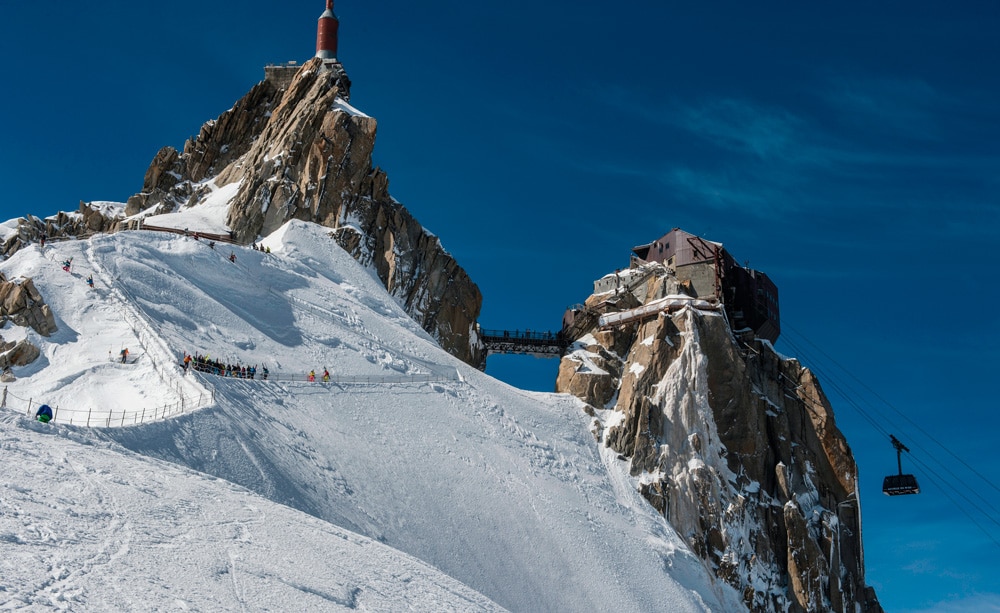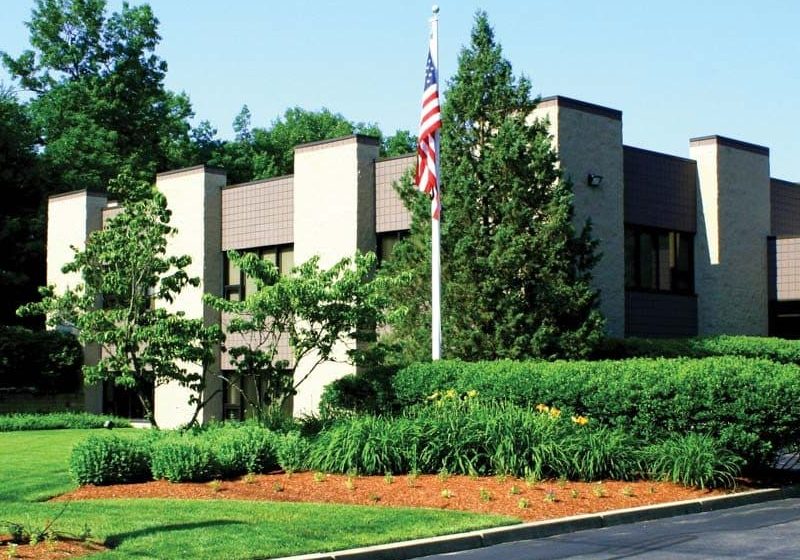Top of the World
Apr 1, 2016

Schindler elevators at Aiguille du Midi in France allow visitors to “step into the void” and enjoy a view of Mont Blanc, the highest summit in the Alps.
The preparations that crews underwent prior to installing a custom Schindler elevator system at the Aiguille de Midi (Needle of the South), in the Mont Blanc massif in France, draws comparisons to those required of an astronaut. The highest elevators in France, the units give thousands of visitors each day access to one of Europe’s top tourist attractions — Step into the Void®, a glass box that allows people to peer into a stunning 1,000-m-deep crevasse. The system — consisting of a pair of Schindler S7000 duplex units — also carries visitors to a viewing platform overlooking Mont Blanc, the Alps’ highest peak.
It is an environment that, though strikingly beautiful, is among the most hostile in the world, with low oxygen, high winds, blizzards, lightning and below-freezing temperatures. Hurricane-force winds have been recorded: in 2009, wind surpassed 134 mph. All who performed the work, which was carried out on a platform specially designed for high-altitude, sub-zero operation, had to undergo thorough medical checks and gradually acclimate themselves to the harsh conditions. François Reutter, director of Schindler France’s High-Rise Division, elaborates:
“We had to take steps to ensure the crew members would be in perfect physical and psychological condition to work efficiently and safely in high altitude and under very negative temperatures for several months in the Aiguille du Midi. Special overalls, fabrics and safety shoes enabled them to adapt to negative temperatures and quickly changing weather conditions, from sun to ice to snow to wind and fog. According to IFREMMONT (Training Institute for Mountain Medicine Research), one in 20 people simply cannot adapt to such a high altitude. Any acclimatization comes at a price: the extra red blood cells make blood stickier and more likely to clot, which increases the risk of thrombosis.”
While the technicians in charge of the elevators’ installation (all from Schindler) had to undergo intense preparation, so did the equipment. Some of it had to be specially built to guard against lightning. In-shaft equipment had to be protected from humidity and -20° C temperatures.
The challenges were remarkable, but so was the end result: a fast, secure, comfortable pair of elevators that is the key part of a complex vertical-transportation system at the site in Chamonix, one of the first ski resorts in France and host of the first Winter Olympics in 1924. It consists of six gondolas, six disengageable chairlifts, 10 fixed-grip chairlifts, nine drag lifts, seven cable cars and two mountain trains.
The elevators opened on August 8 and 15, 2014, one on a sunny and one on a blizzardy day. They were met with great enthusiasm and long queues. Between August 8 (when it went into service) and October 31, 2015, the first elevator made a total of 58,000 trips.
The client was Compagnie du Mont Blanc (CMB), which desired a replacement for the old elevator, custom designed by a French engineering company in the 1960s, that previously provided access to the viewing platform and Step into the Void. The opening of the latter, in December 2013, only enhanced the spot’s popularity, so CMB knew a better elevator system was needed. CMB selected Schindler, a company that had completed such projects as an elevator for the summit of the Klein Matterhorn in Switzerland, one of the highest peaks in Europe at 3,883 m above sea level. CMB President Mathieu Dechevanne and Reutter signed a contract in May 2014. This step led to a new partnership between both enterprises and was celebrated in July 2014 with Schindler Group Vice Chairman Luc Bonnard, who fittingly shook hands with Mathieu in the Step Into the Void glass box. Among CMB’s requirements:
- Security/safety enabling evacuation at any time both from the summit platform and from car to car
- Two separate machine rooms (one for each elevator), so one elevator stays in service during maintenance or repair
- High handling capacity
- Troubleshooting and evacuation training for CMB maintenance staff
- Attractive/distinctive cab interiors
After the original elevator was dismantled, work to widen the 80-m-tall shaft by 70 cm and build the second machine room commenced. Approximately 100 m3 of rock was removed at an altitude of 3,842 m.
An emergency ceiling glass door on each elevator is resistant to falling rock and has the added bonus of allowing passengers to view the rock shaft during their journey. An emergency hand-operated door on one side of the cab in each unit allows evacuation from car to car.
Involving in an atypical environment and shaft, the installation called for numerous special measures. Hundreds of specific bolt anchorages, for example, had to be drilled into the granite due to uneven shaft walls. The sills and electronic systems on the car tops had to be outfitted with heating systems to protect them against damage from snow and ice. The door operator was a high requirement with stainless-steel parts. The car, frame and counterweight were galvanized to prevent rusting. Special protection against lightning was also considered.
Schindler called in key partners on the project: ifremmont as a consultant on “mountain medicine” (medicine in hostile, high-altitude environments), which, togehter with ANANDA Events, put together training programs and medical teams in case anything went awry; ACRO BTP, which provided specialized crews and equipment used to working in very high mountainous environments to perform widening of the shaft; and Chamonix Mont-Blanc Helicopters (CMBH) to provide helicopter transport for frames, pulley frames, car and counterweight guide rails. The other equipment was brought up by cable car.
Reutter recalls the installation was sometimes unreachable due to high winds and snow. The Schindler team typically worked five days a week as long as they were able. He compares this installation to one on a cruise ship: When the ship leaves port, it is no longer reachable by Schindler maintenance technicians. Therefore, Schindler worked out a special training schedule for CMB engineers in order for them to be able to perform basic troubleshooting and passenger evacuation. A hotline with the Schindler branch in charge of maintenance and troubleshooting was also established. Schindler maintenance technicians in charge of the job were also specifically trained prior to handover at the Schindler France Training Center and at the site. Spare parts, stored at proper altitude, were made available. Several components, such as variable-voltage, variable-frequency drives, were available in duplicate.
The units each have a capacity of 630 kg and travel 65 m at 2.5 mps. The cab interiors depict skiing and mountain scenes designed by Schindler and are accented with stainless steel. Schindler believes they are a triumph of form and function. Reutter states:
“This job was much more than just erecting elevators in a mountain. Overall, it was a real human adventure that demanded a high level of preparation, anticipation, courage, team spirit and team cohesion, as well as perfect coordination with the client and all our project partners.”
Get more of Elevator World. Sign up for our free e-newsletter.







